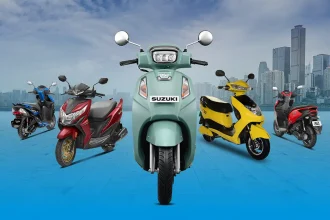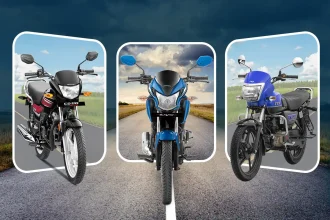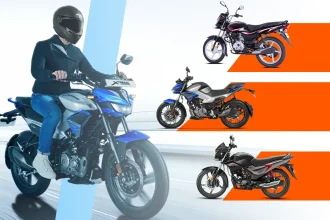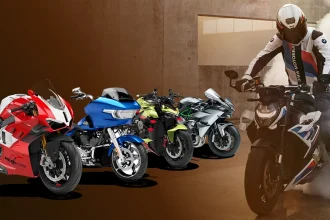Imagine this: You’re driving to work during rush hour. Out of the corner of your eye, you spot a Yamaha RX100—a really old bike. The rider tries to overtake you but loses control of his bike. There’s two outcomes here: either the bike refuses to budge and traffic grinds to a halt, or it malfunctions and causes an accident. Both outcomes are dangerous and inconvenient. Frustrated, you wonder, ‘How many years can a bike be used in India before it poses a danger to the lives of others?’
Unfortunately, an old bike can cause more problems than just mechanical issues. Riding old cars and scooters is fine if they’re well-maintained. However, riding two-wheelers with rusted parts and structural damages isn’t harmful just to you but to everyone else as well. Clearly, how many years can a bike be used in India depends not just on maintenance but also on the legal regulations for old and vintage vehicles.
How Many Years Can A Bike Be Used In India? Find Out Now
To find out how many years can a bike be used in India, we need to understand terms like scrappage, FC, and EOL certificate. This blog breaks down these concepts for you and gives you a clear answer to the question, ‘how many years can a bike be used in India?’
So whether you’re the owner of an old bike, a vintage bike collector, want to buy used bikes, or are simply interested in old bikes in India, put your helmet on and let’s get started!

What Factors Determine How Many Years Can A Bike Be Used In India?
How many years can a bike be used in India? The most straightforward answer is ‘as long as it is legally allowed’. Commuter bikes have an average lifespan of 8–15 years. The manufacturer and model matter too: some old bikes were built with higher-quality materials than their modern-day counterparts. In general, most bikes are built to last and can have extremely long lifespans with proper maintenance.
So, what determines how many years can a bike be used in India legally? The Motor Vehicle Act states that you need to have a valid vehicle registration certificate (RC), a driving license, a PUCC and at least third-party insurance to be able to legally drive on Indian roads. While a driving license isn’t dependent on your bike, the rest of these documents play a huge role in determining how many years can a bike be used in India.
Bike RC: What is a Bike Registration Certificate?
Every vehicle must be linked to its owner to prevent people from using them for illegal activities. This also makes the vehicle (and, by extension, the owner) easier to track in an emergency. An RC, or registration certificate, is the document that connects a bike with its rider. In India, it is illegal to drive any vehicle without a valid RC.
For example, imagine that you’ve just bought a Hero Glamour XTEC. One of the first steps you will take is applying for an RC, since you won’t get your license plates without it. The RTO rules for scrapping vehicles state that all cars, bikes, and other vehicles must have their RC renewed after 15 years. Once your Glamour turns 15, its RC will expire, and you must re-register it at an RTO office to be able to legally ride it.
So does that mean a bike can be used only for 15 years in India? Once your RC expires, you can still re-register your vehicle. So you can technically extend how many years can a bike be used in India. In order to re-register your Glamour XTEC, you will have to prove that it is still safe and compliant with pollution standards. If your bike is deemed unfit for use, you will not be able to ride it in public places. Driving without a valid RC could land you a fine of up to ₹10,000 and even jail time.
Your bike’s first RC will be valid for 15 years, since that is considered the average lifespan of a bike in India by the Motor Vehicle Act. After this, each subsequent RC renewal will be valid for 5 years. You can re-register your bike as many times as you wish, so you could even ride a 35-year-old bike if it has a valid RC.
The New Vehicle Scrappage Policy
The government introduced the new vehicle scrappage policy in 2021. This policy aims to reduce the number of outdated and unfit vehicles on the road. As old vehicles are removed, the demand for new ones will increase, and this will reduce pollution levels, make roads safer, and give a boost to the automobile industry’s growth.
According to the RTO rules for scrapping two-wheelers, after your bike’s RC expires, it must pass a fitness test to be eligible for reregistration. Vehicles that do not pass the fitness test will be considered ‘unregistered’ and eligible for scrapping. The Vehicle Scrappage Policy is valid on all government, commercial, and private vehicles.
While it is currently illegal to use a two-wheeler as a commercial vehicle in some states, the laws around this are slowly changing. Commercial vehicles go through more rigorous use than personal ones and thus are held to stricter standards. A commercial vehicle’s registration certificate is valid for only two years. Once the vehicle is 8 years old, the RC validity is reduced to 1 year. So commercial bike owners must obtain a new RC every year to comply with the bike scrap policy.
The rules for vintage cars and bikes have been modified to reflect their unique characteristics and cater to the sentiments of car collectors.
Fitness Check (FC)
Now, let’s decode what a fitness check or fitness test is. A vehicle fitness test is performed to determine whether a vehicle can be safely driven in public. After your bike’s RC expires, it must pass a fitness test in order to be eligible for reregistration. Most bikes require a fitness test after their lifespan crosses 15 years. You will have to pay a fee to get a fitness check.
Earlier, RTO fitness tests were carried out by an official, who would check your horn, brakes, and lights and start your engine if necessary. But now this test is completely automated, so there is no room for error. Vehicles that do not pass the fitness check are classified as EOLV or End of Life Vehicles. If your bike fails the automated FC test, it will receive an EOLV certificate, and you can no longer reregister it or ride it publicly. You can, however, get it modified or repaired and try taking the test again.
Fitness tests inspect the vehicle and determine how safe it is and how environment-friendly it is. If a bike isn’t well maintained, its emissions can increase as it gets older. The fitness check keeps such polluting vehicles off the streets. This test also checks your bike’s internal components for signs of mechanical failure. Along with RTO FC charges, will also have to pay green tax of 10–15% if your bike is an older model.
You will need the following documents to get your bike fitness certificate.
- Your RC
- Form 21
- Form 22
- PUC certificate
- Pencil print of chassis number
- Identity and address proof
- Passport-size photos
- Valid insurance policy certificate
- Road tax payment receipt
Pollution Under Control (PUC) Certificate
You may already be familiar with this term. Along with a fitness test, you will also have to obtain a PUC for your bike’s re-registration. PUC testing exclusively checks the emission levels of your bike. If the bike’s emission levels don’t comply with the pollution norms, you will receive a rejection slip and will not be able to reregister it.
You can’t legally ride an unregistered bike or even avail mandatory third-party insurance on it. Driving a bike without a PUC will invite all sorts of legal trouble. Luckily for you, you can apply for PUC testing multiple times. Like the fitness test, you can modify, repair, or maintain your bike to make it pass its next PUC test attempt. PUCCs are valid for a year for new bikes and must be renewed every 6 months after.
How Many Years Can A Bike Be Used In India: Why Restrictions are Necessary
Bikes aren’t novelty goods; they withstand years of wear and tear and the harsh tropical conditions of the Indian subcontinent. 15 years is a long time and most bike owners don’t really plan on keeping them past that point. For a bike to make it past 15 years, it must be in excellent condition and be rigorously and carefully maintained.
Newer Bikes are Better for the Environment
Every day, thousands of people buy bikes in India. As a rapidly growing automobile market, the country faces the significant threat of rising pollution levels. That is why the government regularly releases a new set of regulations that car and bike manufacturers must comply with. These are called emission standards, and they get stricter every year. India’s emission norms for vehicles are set by the Central Pollution Control Board (CPCB) and are based on the Bharat Stage (BS) standards.
In 1991, a bike would have to produce less than 12–30 g/km for it to be legal. Today, all bikes must produce less than 2 g/km according to Bharat Stage VI emission standards. That’s a huge difference! As climate change gets worse, new rules for old vehicles in India will keep pushing for the ban on non-environmentally friendly vehicles.
Newer Bikes Are Safer
Newer bikes are much safer for you, too. Just think about how disastrous it would be if your bike’s wheels locked up every time you braked! ABS, the technology that prevents this from happening, was only featured on a few old bike models. Post 2019, all bikes below 150 cc, like the Keeway SR125, feature CBS (combined braking system) and those above 150 cc, like the Pulsar 150, are equipped with standard ABS as per government mandates.
LED headlamps and DRLs provide excellent visibility when you’re riding a bike. These features weren’t popular earlier either. Better safety features reduce the risk of accidents and make driving safer.
How Many Years Can A Bike Be Used In India If It Is A Vintage Model?
A vintage car or bike isn’t going to be used as often as your standard old vehicle. They are usually very well maintained and thus don’t abide by the same scrappage rules as other vehicles.
In India, vehicles that are over 50 years old from their date of registration can be registered as ‘Vintage Motor Vehicles’. To classify as a vintage bike, your motorcycle must be maintained in its original form without any significant modifications or overhauls in the outer body, engine, or chassis. A new vintage vehicle registration will cost ₹20,000 and be valid for 10 years (as opposed to 15 years for regular vehicles). Reregistration will cost ₹5000 and must be renewed every five years.
Newly registered vintage bikes and cars will get a special numberplate with VA for vintage. If you own a vintage bike, you cannot use it for ‘regular and commercial purposes’. While you can’t use your vintage Royal Enfield for your daily commute, you can ride it to a vintage bike rally or take it out for an occasional ride.
You will also not need a PUCC or an FC to register your vintage bike; most old vehicles would not be able to meet the emission requirements without heavy modifications that could compromise the safety and originality of a vintage vehicle. To register a vintage bike, you’ll need its insurance papers, the old registration certificate (if applicable) and a bill of entry if it was imported.
How Many Years Can A Bike Be Used In India in Delhi NCR?
The National Green Tribunal and the Supreme Court have issued a ruling stating that petrol vehicles older than 15 years and diesel vehicles older than 10 years would not be allowed in the Delhi-NCR region regardless of their fitness. This decision aims to curb the growing pollution levels in Delhi.
Bikes and cars that are older than 15 years must not be found riving or parked in public. If a bike older than 15 years is found, the owner must pay a fine of ₹10,000 and submit an undertaking stating that they will not be driven on public roads and park in private spaces to get their bike released. There is also a risk that your vehicle will be directly sent to a scrappage facility when impounded.
Vintage vehicles are exempt from this ruling. Since vintage vehicles cannot be used for ‘personal and commercial use’, this has caused miscommunications between cops and vintage vehicle owners in Delhi. If you own a vintage bike, you should not use it for your daily commute or any commercial activities.
Conclusion
If you are attached to your bike for sentimental reasons, you may feel like the government is trying to snatch it away from you. That couldn’t be further from the truth. The scrapping policy puts safety first and deems it irresponsible for riders to jeopardize the lives of others. So while you can’t ride your old, unsafe bike in public places, you can still keep it home in a garage. You could even ride it on private property, as long as you aren’t endangering others!
The new scrapping policy makes it harder to own old vehicles that are unsafe or aren’t properly maintained. It also encourages the sale of new bikes and promotes the recycling of old ones. You can still ride your old bike once it is properly maintained and able to pass fitness checks.
Learn about bike insurance and the financial aspects of car and bike ownership with blogs from AUTOLIVENEWS. Keep reading to know which engine oil is best for bikes, how to renew expired bike insurance, and more!
Leave a comment if you enjoyed reading this blog and let us know what we should cover next!
Frequently Asked Questions (FAQs)
How many years can a bike be used in India?
You can use a bike for as long as it has a valid RC and passes fitness checks. After the first 15 years, each re-registration is valid for 5 years.
Can we use bikes older than 15 years in India?
Yes, you can use an old bike in India by applying for RTO re-registration and getting a fitness check done.
Can I get a fitness certificate for a bike after 15 years?
Yes, after your bike’s first fitness certificate expires, you can get a new fitness check done at authorized automated testing centers.
How do I make an application for a fitness certificate?
You can apply for a fitness check at the Parivahan Sewa website online or at an RTO office offline.















